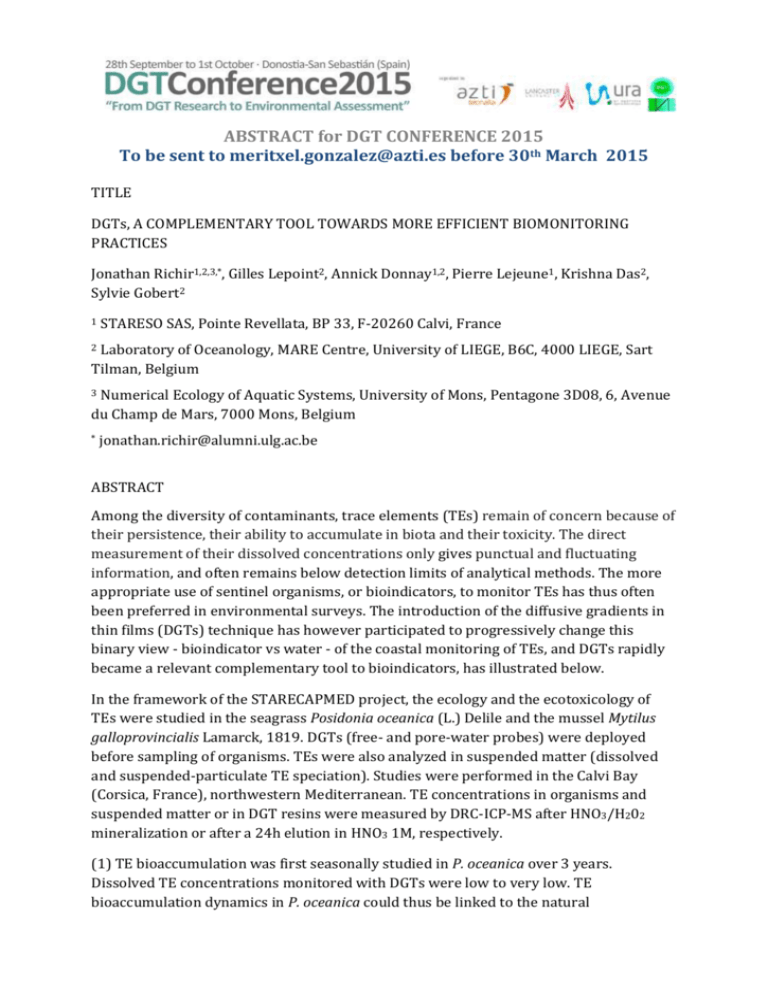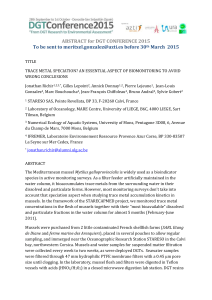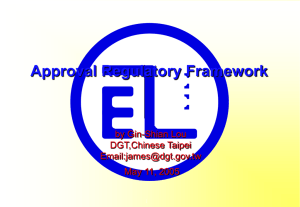Richir et al._DGT-conference-2015_talk_published
advertisement

ABSTRACT for DGT CONFERENCE 2015 To be sent to meritxel.gonzalez@azti.es before 30th March 2015 TITLE DGTs, A COMPLEMENTARY TOOL TOWARDS MORE EFFICIENT BIOMONITORING PRACTICES Jonathan Richir1,2,3,*, Gilles Lepoint2, Annick Donnay1,2, Pierre Lejeune1, Krishna Das2, Sylvie Gobert2 1 STARESO SAS, Pointe Revellata, BP 33, F-20260 Calvi, France Laboratory of Oceanology, MARE Centre, University of LIEGE, B6C, 4000 LIEGE, Sart Tilman, Belgium 2 Numerical Ecology of Aquatic Systems, University of Mons, Pentagone 3D08, 6, Avenue du Champ de Mars, 7000 Mons, Belgium 3 * jonathan.richir@alumni.ulg.ac.be ABSTRACT Among the diversity of contaminants, trace elements (TEs) remain of concern because of their persistence, their ability to accumulate in biota and their toxicity. The direct measurement of their dissolved concentrations only gives punctual and fluctuating information, and often remains below detection limits of analytical methods. The more appropriate use of sentinel organisms, or bioindicators, to monitor TEs has thus often been preferred in environmental surveys. The introduction of the diffusive gradients in thin films (DGTs) technique has however participated to progressively change this binary view - bioindicator vs water - of the coastal monitoring of TEs, and DGTs rapidly became a relevant complementary tool to bioindicators, has illustrated below. In the framework of the STARECAPMED project, the ecology and the ecotoxicology of TEs were studied in the seagrass Posidonia oceanica (L.) Delile and the mussel Mytilus galloprovincialis Lamarck, 1819. DGTs (free- and pore-water probes) were deployed before sampling of organisms. TEs were also analyzed in suspended matter (dissolved and suspended-particulate TE speciation). Studies were performed in the Calvi Bay (Corsica, France), northwestern Mediterranean. TE concentrations in organisms and suspended matter or in DGT resins were measured by DRC-ICP-MS after HNO3/H202 mineralization or after a 24h elution in HNO3 1M, respectively. (1) TE bioaccumulation was first seasonally studied in P. oceanica over 3 years. Dissolved TE concentrations monitored with DGTs were low to very low. TE bioaccumulation dynamics in P. oceanica could thus be linked to the natural ABSTRACT for DGT CONFERENCE 2015 To be sent to meritxel.gonzalez@azti.es before 30th March 2015 physiological cycle of the plant, in clean environmental conditions. (2) To complement that field survey, isolated seagrasses were in situ contaminated with TEs at environmental relevant concentrations. Through the use of DGTs, TE uptake kinetics were modelled for seagrasses exposed to know bioavailable concentrations of contaminants, as were loss kinetics during the following depuration phase. The TE sequestration ability of a healthy P. oceanica meadow facing sudden trace metal contamination events could also be quantified. (3) The deployment of pore-water DGT probes in bare-sand or seagrass colonized sediments further showed that, through its stabilizing function of the seabed, P. oceanica maintained higher TE levels in the porewater. P. oceanica meadows thus offer a significant “depuration-filtering” ecological service along highly anthropized Mediterranean coasts. M. galloprovincialis are widely used in large spatial scale coastal monitoring surveys. (4) The deployment of caged mussels together with DGTs showed that the little contaminated water body of the Calvi Bay was relatively homogenous. It also allowed to calculate TE bioaccumulation towards mussels in reference conditions, and to compare it to native mussel populations. (5) Finally, during a 5 months mussel caging survey, mussels and suspended matter were collected weekly to monthly, such as were deployed DGTs. The physiological status of mussels, the speciation of TEs between their dissolved and suspended-particulate phases, and their relative influence on TE bioaccumulation dynamics in mussels were investigated. In conclusion, these case studies properly demonstrate how DGT probes can be used as a relevant and complementary tool to bioindicators. Their concomitant use should therefore be privileged in monitoring surveys. KEY WORDS DGT, monitoring, bioindicator, trace element speciation TO BE PRESENTED IN SESSION… Session 1 Water solutions and aquatic environments (continental, brackish and marine waters) ORAL COMMUNICATION









